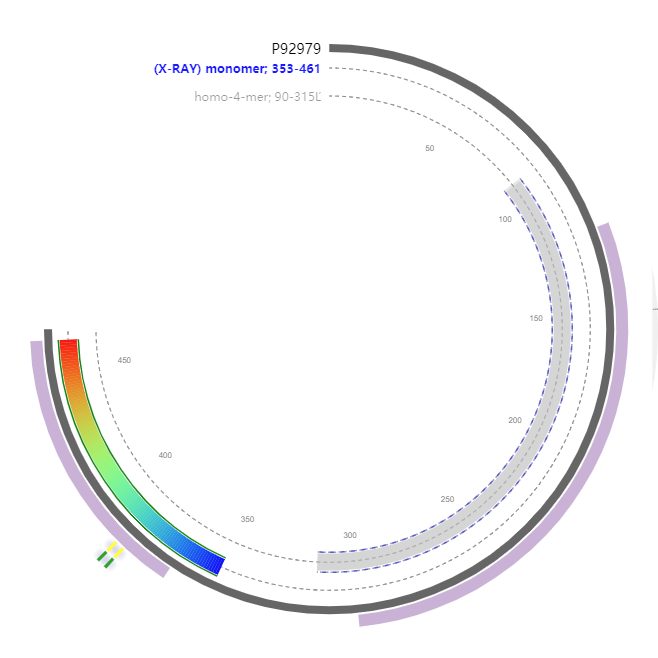Reduces sulfate for Cys biosynthesis. Substrate preference is adenosine-5'-phosphosulfate (APS) >> 3'-phosphoadenosine-5'-phosphosulfate (PAPS). •
MAMSVNVSSSSSSGIINSRFGVSLEPKVSQIGSLRLLDRVHVAPVSLNLSGKRSSSVKPL
NAEPKTKDSMIPLAATMVAEIAEEVEVVEIEDFEELAKKLENASPLEIMDKALEKYGNDI
AIAFSGAEDVALIEYAHLTGRPFRVFSLDTGRLNPETYRFFDAVEKHYGIRIEYMFPDSV
EVQGLVRSKGLFSFYEDGHQECCRVRKVRPLRRALKGLKAWITGQRKDQSPGTRSEIPVV
QVDPVFEGLDGGVGSLVKWNPVANVEGNDVWNFLRTMDVPVNTLHAAGYISIGCEPCTKA
VLPGQHEREGRWWWEDAKAKECGLHKGNVKENSDDAKVNGESKSAVADIFKSENLVTLSR
QGIENLMKLENRKEPWIVVLYAPWCPFCQAMEASYDELADKLAGSGIKVAKFRADGDQKE
FAKQELQLGSFPTILVFPKNSSRPIKYPSEKRDVESLTSFLNLVR472

| PMID | Title & Author | Abstract | Year | |
| 0 | 8917599 | Three members of a novel small gene-family from Arabidopsis thaliana able to complement functionally an Escherichia coli mutant defective in PAPS reductase activity encode proteins with a thioredoxin-like domain and "APS reductase" activity.Gutierrez-Marcos JF, Roberts MA, Campbell EI, Wray JL | Three different cDNAs, Prh-19, Prh-26, and Prh-43 [3'-phosphoadenosine-5'-phosphosulfate (PAPS) reductase homolog], have been isolated by complementation of an Escherichia coli cysH mutant, defective in PAPS reductase activity, to prototrophy with an Arabidopsis thaliana cDNA library in the expression vector lambda YES. Sequence analysis of the cDNAs revealed continuous open reading frames encoding polypeptides of 465, 458, and 453 amino acids, with calculated molecular masses of 51.3, 50.5, and 50.4 kDa, respectively, that have strong homology with fungal, yeast and bacterial PAPS reductases. However, unlike microbial PAPS reductases, each PRH protein has an N-terminal extension, characteristic of a plastid transit peptide, and a C-terminal extension that has amino acid and deduced three-dimensional homology to thioredoxin proteins. Adenosine 5'-phosphosulfate (APS) was shown to be a much more efficient substrate than PAPS when the activity of the PRH proteins was tested by their ability to convert 35S-labeled substrate to acid-volatile 35S-sulfite. We speculate that the thioredoxin-like domain is involved in catalytic function, and that the PRH proteins may function as novel "APS reductase" enzymes. Southern hybridization analysis showed the presence of a small multigene family in the Arabidopsis genome. RNA blot hybridization with gene-specific probes revealed for each gene the presence of a transcript of approximately 1.85 kb in leaves, stems, and roots that increased on sulfate starvation. To our knowledge, this is the first report of the cloning and characterization of plant genes that encode proteins with APS reductase activity and supports the suggestion that APS can be utilized directly, without activation to PAPS, as an intermediary substrate in reductive sulfate assimilation. | 1996 |
| 1 | 8917600 | Sulfate reduction in higher plants: molecular evidence for a novel 5'-adenylylsulfate reductase.Setya A, Murillo M, Leustek T | Sulfate-assimilating organisms reduce inorganic sulfate for Cys biosynthesis. There are two leading hypotheses for the mechanism of sulfate reduction in higher plants. In one, adenosine 5'-phosphosulfate (APS) (5'-adenylysulfate) sulfotransferase carries out reductive transfer of sulfate from APS to reduced glutathione. Alternatively, the mechanism may be similar to that in bacteria in which the enzyme, 3'-phosphoadenosine-5'-phosphosulfate (PAPS) reductase, catalyzes thioredoxin (Trx)-dependent reduction of PAPS. Three classes of cDNA were cloned from Arabidopsis thaliana termed APR1, -2, and -3, that functionally complement a cysH, PAPS reductase mutant strain of Escherichia coli. The coding sequence of the APR clones is homologous with PAPS reductases from microorganisms. In addition, a carboxyl-terminal domain is homologous with members of the Trx superfamily. Further genetic analysis showed that the APR clones can functionally complement a mutant strain of E. coli lacking Trx, and an APS kinase, cysC. mutant. These results suggest that the APR enzyme may be a Trx-independent APS reductase. Cell extracts of E. coli expressing APR showed Trx-independent sulfonucleotide reductase activity with a preference for APS over PAPS as a substrate. APR-mediated APS reduction is dependent on dithiothreitol, has a pH optimum of 8.5, is stimulated by high ionic strength, and is sensitive to inactivation by 5'-adenosinemonophosphate (5'-AMP). 2'-AMP, or 3'-phosphoadenosine-5'-phosphate (PAP), a competitive inhibitor of PAPS reductase, do not affect activity. The APR enzymes may be localized in different cellular compartments as evidenced by the presence of an amino-terminal transit peptide for plastid localization in APR1 and APR3 but not APR2. Southern blot analysis confirmed that the APR clones are members of a small gene family, possibly consisting of three members. | 1996 |
| 2 | 9653199 | Glutaredoxin function for the carboxyl-terminal domain of the plant-type 5'-adenylylsulfate reductase.J A Bick | 5'-Adenylylsulfate (APS) reductase (EC 1.8.99.-) catalyzes the reduction of activated sulfate to sulfite in plants. The evidence presented here shows that a domain of the enzyme is a glutathione (GSH)-dependent reductase that functions similarly to the redox cofactor glutaredoxin. The APR1 cDNA encoding APS reductase from Arabidopsis thaliana is able to complement the cysteine auxotrophy of an Escherichia coli cysH [3'-phosphoadenosine-5'-phosphosulfate (PAPS) reductase] mutant, only if the E. coli strain produces glutathione. The purified recombinant enzyme (APR1p) can use GSH efficiently as a hydrogen donor in vitro, showing aKm[GSH] approximately of 0.6 mM. Gene dissection was used to express separately the regions of APR1p from amino acids 73-327 (the R domain), homologous with microbial PAPS reductase, and from amino acids 328-465 (the C domain), homologous with thioredoxin. The R and C domains alone are inactive in APS reduction, but the activity is partially restored by mixing the two domains. The C domain shows a number of activities that are typical of E. coli glutaredoxin rather than thioredoxin. Both the C domain and APR1p are highly active in GSH-dependent reduction of hydroxyethyldisulfide, cystine, and dehydroascorbate, showing a Km[GSH] in these assays of approximately 1 mM. The R domain does not show these activities. The C domain is active in GSH-dependent reduction of insulin disulfides and ribonucleotide reductase, whereas APR1p and R domain are inactive. The C domain can substitute for glutaredoxin in vivo as demonstrated by complementation of an E. coli mutant, underscoring the functional similarity between the two enzymes. | 1998 |
Plant Adenosine 5′-Phosphosulfate Reductase Is a Novel Iron-Sulfur Protein *[J]. Journal of Biological Chemistry, 2001, 276(46):42881-6.